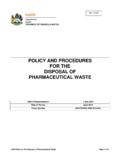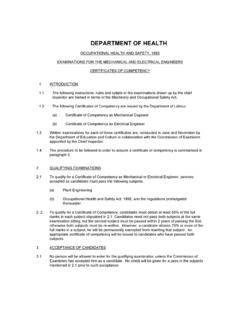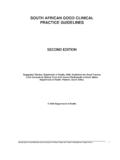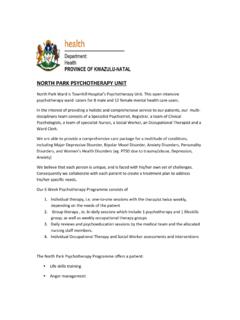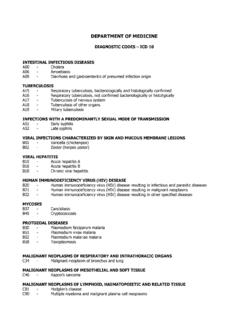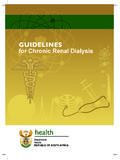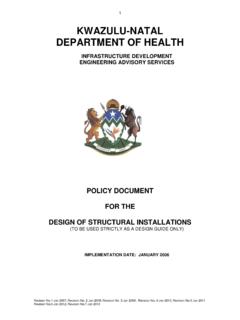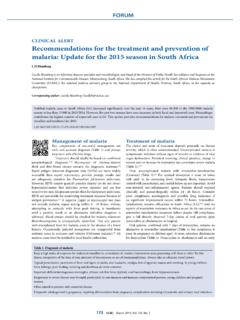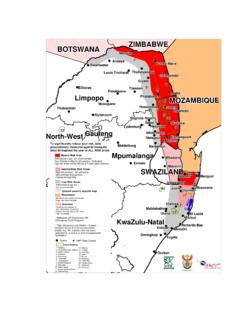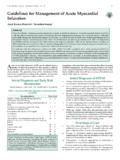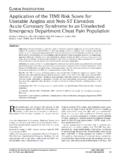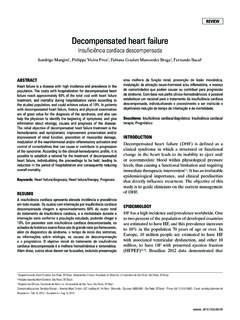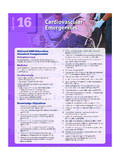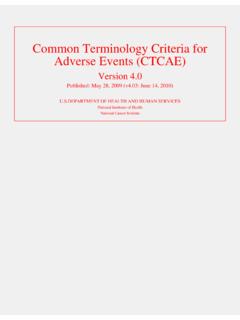Transcription of Biochemical cardiac markers in acute coronary …
1 Biochemical cardiac markers INACUTE coronary SYNDROMEBY DR L A GOVENDERPATHOPHYSIOLOGY OF myocardial INFARCTIONTHE PATHOPHYSIOLOGY OF acute coronary THE PATHOPHYSIOLOGY OF acute coronary SYNDROMES AND BIOMARKERS RELEASED INTO SYNDROMES AND BIOMARKERS RELEASED INTO BLOODBLOODC ontinuum of AMI riskContinuum of AMI riskPlaque rupture Plaque rupture CC--reactive proteinreactive proteinIntracoronary thrombus Intracoronary thrombus , , fibrinopeptidefibrinopeptideAAReduced blood flow Reduced blood flow myocardial perfusion imagingMyocardial perfusion imagingMyocardial ischemia myocardial ischemia IschemiaIschemia--modified albuminmodified albuminMyocardial necrosis myocardial necrosis Troponin, myoglobin, CKTroponin, myoglobin, CK--MB MB (IRREVERSIBLE DAMAGE)(IRREVERSIBLE DAMAGE)
2 Unstable anginaUnstable anginaMyocardial InfarctionMyocardial InfarctionAsymptomaticAsymptomatic acute coronary syndromes are due to an acute or sub acute primary reduction of myocardial oxygen supply provoked by disruption of an atherosclerotic plaque associated with inflammation, thrombosis, vasoconstriction and microembolization. Finite process. (>4-6 h for necrosis to develop).The term acute coronary Syndrome refers to a range of acute myocardial ischaemic states. coronary Artery Diseases (CAD) : a continuum of increasing risk of morbidity and mortality: Starts with asymptomatic CAD Develops through stable and unstable angina Progresses to non-Q-wave MI ends in transmural MI, cardiac arrhythmia, and death myocardial infarction is the terminal event in a spectrum of disease called acute coronary syndromes (ACS) and caused by acute myocardial Continuum ACS ContinuumACSPATHOPHYSIOLOGY OF myocardial INFARCTIONP laque disruption or erosionThrombus formation with or without embolisationAcute cardiac ischaemiaNo ST segment elevationST segment elevationElevated markers of myocardial necrosisST segment elevation myocardial infarction (Q waves usually present)
3 markers of myocardial necrosis not elevatedElevated markers of myocardial necrosisUnstable anginaNon-ST segment elevation myocardial infarction (Q waves usually absent) acute coronary syndromesSpectrum of acute coronary syndromes according to electrocardiography and Biochemical markers of myocardial necrosis (troponin T, troponin I and creatine kinase MB), in patients presenting with acute cardiac chest painGrech,BMJ 7/6/2003 326, 259-261 AMI or unstable angina is initiated by acute plaque rupture and resulting in thrombus formation with or withoutembolisation. The development of infarction or ischaemia will depend on the degree of occlusion or the presence of collateral blood role of cardiac markers in the diagnosis and treatment of patients with chest pain and suspected ACS has evolved clinical evaluation often is limited by atypical symptoms, in most patients the initial ECG is CRITERIA FOR DIAGNOSIS OF MI (WHO, 1974) Triad of criteria Diagnosis requires Two of.
4 Severe & prolonged chest pain Unequivocal ECG changes consistent with acute MI Elevated serum cardiac enzymesHowever, new guidelines by American College of Cardiology (ACC) and theEuropean Society of Cardiology (ESC) have redefined AMI and focuses onthe importance of cardiac Criteria: acute /Evolving/ Recent MI Typical myocardial necrosis-associated rise & fall of Troponin or CK-MBmass (serial determinations)PLUS One of: Clinical cardiac ischaemia (or equivalents*) Q waves on ECG ST segment changes indicative of ischaemia coronary artery imaging (stenosis/obstruction) ORPathologic findings of an acute MIESC/ACC AMI REDEFINEDThis is a significant change from the WHO classification because patients who were formally diagnosed with unstableangina or minor myocardial injury are now reclassified as having acute cardiac MARKERSWHAT ARE cardiac markers ?
5 Located in the myocardium Released in cardiac injury myocardial infarction Non-Q-wave infarction Unstable angina pectoris Other conditions affecting cardiac muscle (trauma, cardiac surgery, myocarditis etc.) Can be measured in blood samplesCARDIAC MUSCLE CELLSize and subcellular distribution of myocardial Size and subcellular distribution of myocardial proteins/ markers determines time course of proteins/ markers determines time course of biomarker appearance in the general circulationbiomarker appearance in the general circulationPATHOPHYSIOLOGY OF acute coronary SYNDROMES & BIOMARKER RELEASE INTO THE CIRCULATIONC oronary artery occlusionMyocardial ischaemiaAnoxiaLack of collateral blood flowReversible damageIrreversible damageCell death and tissue necrosisATP pump failureLeakage of ions, potassiumAccumulation of metabolitesleakage of metabolites.
6 LactateMembrane damageLeakage of myocardial proteins & enzymesQUESTIONS ANSWERED BY markers OF cardiac DAMAGE Rule in/out an acute MI Confirm an old MI (several days) Monitor reinfarction Monitor the success of thrombolysis Risk stratification of patients with Risk stratification in apparently healthy persons notdone with cardiac markers , but by measurement and assessment of cardiac RISK factorsRELEASE KINETICS OF myocardial CELL CONSTITUENTSBIOCHEMICAL markers IN myocardial ISCHAEMIA / NECROSISIN: CK-MB (mass) (I or T) MyoglobinOUT: AST activity LDH activity LDH isoenzymes CK-MB activity CK-Isoenzymes ?CK-TotalFUTURE: Ischaemia Modified Albumin Fatty Acid binding protein CD40 Ligand binding proteinCK-MB ISOENZYMES CK-MB iso-enzymes have been Biochemical indicator of choice for the diagnosis of AMI.
7 Cardio-specificity of CK-MB is not 100% They are present in both skeletal and cardiac muscle. False positive elevation occurs in trauma,heavy exertion and myopathies. First appears 4-6 hours after symptoms onset. Peaks at 24 hours. Returns to normal in 48-72 is a heme-protein found in skeletal and cardiac muscleIt is currently the earliest markerRises 2-4 hours after onset of infarctionPeaks at 6-12 hoursReturns to normal within 24-36 hoursImportant for ruling out MI rather than ruling are regulatory proteins found in skeletal and cardiac subunits are identified, namelyTroponin ITroponin TTroponin CCARDIAC TROPONINS Striated and cardiac muscle filaments consist of: Actin Myosin Troponin regulatory complex Troponin complex: 3 distinct sub-units on thin filament: TnC, TnT & TnI, which regulate myosin-actin Ca-dependent interaction.
8 TnT & TnI sub-units of skeletal & myocardial troponin are sufficiently different for antisera to differentiate between two tissue forms A fraction of total troponin is found free dissolved in the cytosolTroponin I and T Troponins have high specificity for myocardial injury Sensitive to minor myocardial damage Appear 4-8 hours after symptoms onset Remain elevated for upto 14 days post MI Useful in risk stratification of patients with ACS Useful in identifying patients with high risk of adverse markers IN ACS UNSTABLE ANGINA PECTORIS (UA) cTnI & cTnT are often elevated in UA without additional clinical signs (ECG) or classical laboratory signs of acute MI (raised CK-MB)
9 These patients have a high risk of cardiac eventsTROPONINSBIOCHEMICAL markers IN ACS RISK STRATIFICATION IN UAIrreversible minor myocardial injury detected by TnT/I may stratify UA patients as high risk for progression to AMIINCIDENCE OF DEATH OR MI IN ACS PATIENTSB aseline levels of troponin have been shown to predict the risk of adverse cardiac events in patients with non-ST elevation ACSTROPONIN AND MI DIAGNOSISIt is estimated that about 30% of patients who present with chest pain without ST-segment elevation and would otherwise be diagnosed as having unstable angina because of a lack of CK-MB elevation actually have NSTEMI when assessed with cardiac -specific troponin and Circulation 2002 Non ST Elevation Ischemic DiscomfortTroponin(admission and 6-12 hrs)TroponinNegativeTroponinPositiveNSTE MI -High RiskLow riskOther disease?
10 Troponin can be used to efficiently categorise patients into high and low riskgroups for appropriate management OF RISK/PROGNOSISTROPONINSRISK STRATIFICATION IN ACSU seful for: Selection of the site of care coronary care unit versus monitored step-down unit or outpatient setting Selection of appropriate therapy Aggressive versus conservative therapy LMW Hep / GPIIb/IIIa inhibitors can erase increased risk in patients with NSTEMI TnT elevations (Bock, 2002)OTHER cardiac MARKERSI schaemic Modified Albumin (IMA) IMA is a novel marker of ischaemia based on the modification of cobalt to albumin in ischaema is currently undergoing is a marker sensitive for ischaemia rather than necrosis.
